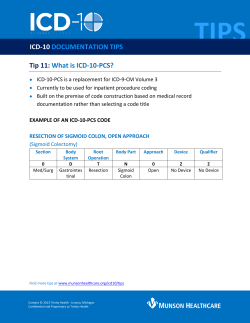
Next Generation Sequencing Method for Illumina Hamilton STAR
Next Generation Sequencing Method for Illumina TruSeq DNA Sample Preparation Protocol on the Hamilton STAR Authors Lance Larka1, Bret Martin2, Bronson Duck2, Navjot Kaur2, Bobby Chavli2, 1Oblique Bio, Inc. Huntsville, Alabama 2 Hamilton Robotics, Reno, Nevada Method validation and testing performed by Oblique Bio, Inc. More information can be found at http://www.ObliqueBio.com/ Abstract Introduction Next Generation Sequencing (NGS) has accelerated the sequencing of genomes and this technology has a major role to play in the biomedical research. The simplicity of NGS library preparation, the ability to make these libraries from tiny input amounts of DNA, the elimination of a bacterial cloning intermediate and the development of data-analysis approaches to support the increasing size of the sequence datasets have been invaluable in the advancement of NGS. This application note describes the automation of the Illumina TruSeq DNA sample preparation on the Hamilton STAR (Figure 1). The data presented includes PicoGreen assay and Sybr E-Gel results for comparison of library construction using automated and manual methods, Bioanalyzer and KAPA assay results and data from Illumina HiSeq. Automation allowed processing 96 samples simultaneously in less than 4 hrs. Sample recovery yields higher by 50% were obtained with automated compared to manual method. The sample preparation provided average 80% reads on target from Illumina HiSeq. The library preparation method and system setup are based on the low throughput portion of the Illumina TruSeq DNA Sample Preparation Guide (P/N 15005180 Rev A). Modifications to the low throughput protocol have been made to accommodate up to 96 samples. The 1000 µL independent channels are used for all bulk reagent liquid transfers on Hamilton STAR and CORE Grippers are used for all labware move steps. The 96 Channel CORE Multiprobe Head is used to pick up single rows of tips for all enzymatic and library oligos. The 96 Channel CORE Multiprobe Head is used for all paramagnetic bead wash and elution steps. The purpose of the TruSeq sample preparation protocol is to add adapter sequences onto the ends of DNA fragments to generate multiplexed sequencing libraries. Good liquid handling is crucial for pipetting precise volumes for example for Agilent Bioanalyzer. The protocol is optimized for 1 µg input DNA. Figure 1: The Hamilton Robotics Microlab® STAR Automated Workstation Workflow Purified Genomic DNA *off-line: Fragment DNA End Repair reaction setup *off-line: optional to do reaction on instrument Purify with AMPure XP beads dA Tailing reaction setup *off-line: optional to do reaction on instrument Purify with AMPure XP beads Adapter Library Ligation reaction setup *off-line: optional to do reaction on instrument Purify with AMPure XP Beads Transfer to PCR plate Process Steps: Process Tip Usage Perform End Repair Add Fragmented DNA to IMP PCR Plate 96 50µL tips Add End Repair Control (or Resuspension Buffer) to IMP 96 50µL tips Add End Repair Mix and mix 96 300µL tips Clean Up IMP Add AMPure XP Beads to IMP (pre-mix if beads have settled) and mix 96 300µL tips Incubate IMP at room temperature for 15 minutes Move IMP from plate carrier to magnetic plate stand and wait for 15 minutes Remove supernatant from IMP and transfer to waste trough 96 300µL tips Add 80% Ethanol to IMP 96 300µL tips Incubate IMP at room temperature for 30 seconds Remove from IMP and transfer to waste trough Add 80% Ethanol to IMP Incubate IMP at room temperature for 30 seconds 96 300µL tips CONTINUED Remove from IMP and transfer to waste trough 96 300µL tips Add 80% Ethanol to IMP Incubate IMP at room temperature for 30 seconds Remove from IMP and transfer to waste trough Move IMP from magnetic stand to plate carrier and wait for 15 minutes 96 50µL tips Add Resuspension Buffer to IMP and mix Incubate IMP at room temperature for 2 minutes Move IMP from plate carrier to magnetic plate stand and wait for 5 minutes Add supernatant from IMP to ALP PCR plate Discard IMP to waste and move ALP to original IMP plate carrier position Adenylate 3’ Ends Add A-Tailing Control (or Resuspension Buffer) to bottom of ALP wells 96 50µL tips Add A-Tailing Mix to bottom of ALP wells and mix 96 50µL tips Add Ligate Control (or Resuspension Buffer) to ALP 96 50µL tips Add Ligate Mix to ALP 96 50µL tips Add DNA Adapters to ALP and mix 96 50µL tips Add Stop Ligate Mix to ALP and mix 96 50µL tips Clean Up ALP Similar to Clean Up IMP Clean Up CAP Similar to Clean Up IMP Enrich DNA Fragments - Make PCR Add PCR Primer Cocktail to PCR plate 96 50µL tips Add PCR Master Mix to PCR plate and mix 96 50µL tips Prompt user to remove PCR plate and Amplify offline Clean Up PCR Similar to Clean Up IMP Method Overview The Hamilton Microlab STAR had been configured with the following components: XX (8) 1000 µL independent pipetting channels XX 96 channel CORE Multi Probe Head XX CORE GRIP 1 mL (PN 184089) XX PLT_CAR_L5AC (PN 182090) XX TIP_CAR_NTR (PN 182074) XX 300 µL CORE tips without filter in nestable tip racks (PN 235950) XX 50 µL CORE tips without filter in nestable tip racks (PN 235947) XX Cooling option comprising of Inheco CPA kit quantity 2 (PN 59146-01), Inheco Multi-TEC Control (PN OTP-8900030) and carrier baseplate for up to 4 heater-shakers (PN 187001) is optional XX 24 Post Magnetic Separator (PN OTP-5-0020) The list of consumables required is: XX Axygen 500uL V bottom Assay Plate (PN P-96-450V-C) XX TruSeq DNA Sample Preparation Kit, Box B1,2 (PN 15013001) XX Axygen 12 columns Low Profile Reservoir (PN RES-MW12-MP) XX TruSeq DNA Sample Preparation Kit, PCR Prep Box1 (PN 15012995) XX Axygen Single Well, 96 tip High Profile Reservoir (PN RES-SW96HP) XX Agencourt AMPure XP 60 ml kit (PN A63881) XX 96 Well 0.2mL Full Skirted PCR Plate Certain universally available materials in these kits were sourced from alternate vendors. XX Adhesive backed aluminum foil seal 2 1 Custom adapter oligos were synthesized by Oblique Bio. XX TruSeq DNA Sample Preparation Kit, Box A (PN 15012999) 1 The deck layout used for the method is given in Figure 2 below. Elution Troughs Enzyme Mixes Wash Adapter Libraries NTR Racks Magnet Station AMPure XP Beads Nonmagnet Station Figure 2: STAR deck software visualization for different stages of the protocols. The library preparation starts with off-line Covaris shearing that generates dsDNA fragments with 3’ or 5’ overhangs. The fragmentation process was optimized to obtain 300-400 bp average insert size for genomic sequencing (Table 1). Volume 50uL Duty Cycle 20% Intensity 5 Cycles per burst 200 Time 165 seconds z-height offset 6 mm Table 1: Covaris Parameters This is followed by End Repair reaction which converts the overhangs into blunt ends using an End Repair Mix. The dA Tailing reaction results in adding a single ‘A’ nucleotide to the 3’ ends of the blunt fragments. Finally ligate multiple indexing adapters to the ends of the DNA fragments, and transfer them to PCR enrichment plate, thus preparing them for hybridization onto a flow cell of HiSeq. There are intermittent clean up steps using the AMPure XP beads. Results The yield from sample preparation was determined by using PicoGreen assay (Figure 3) and the PCR amplification product was run on a gel (Figure 4). The quality of the samples was verified with Bioanalyzer and KAPA assay (Figures 5 and 6; Table 2). The sequencing data is shown from Illumina HiSeq in Table 3. Figure 3: Paired-end Illumina libraries constructed from 1µg of genomic DNA using the Hamilton STAR 96 well automation protocol compared to manual preparation by multichannel pipetor and paramagnetic bead cleanups between each enzymatic step. (A) Final concentrations of libraries prepared using the automation protocol (red) or manual (gray) were determined by PicoGreen assay using a stock 100ng/ µL standard sheared by Covaris to approximately the same size as genomic DNAs used for library input. (B) Average library concentrations of samples prepared by automation show a significantly higher yield than those prepared manually. Figure 4: Post 4-plex pool & PCR enrichment results. 2% Sybr E-Gel. Figure 5: Post 4-plex Bioanalyzer 2100 summary results. Figure 6: Post 4-plex Bioanalyzer 2100 representative results. Hamilton STAR plate Analysis Bioanalysis results KAPA Assay Results 4 plex ng/ul size bp ug DNA nM Yield pM K APA result total lib(15nM) A5 8.99 290 0.35 46.97 0.77 25.05 B5 5.36 290 0.21 28.00 1.18 22.80 C5 4.97 290 0.19 25.97 1.32 23.78 D5 6.76 290 0.26 35.32 1.09 26.66 E5 15.05 290 0.59 78.63 0.34 18.49 F5 7.47 300 0.29 37.73 0.74 18.74 G5 7.23 290 0.28 37.77 0.87 22.83 H5 7.21 300 0.28 36.41 0.93 22.67 A6 8.49 290 0.33 44.36 0.92 28.30 B6 7.92 295 0.31 40.68 0.94 25.96 C6 6.89 290 0.27 36.00 0.90 22.32 D6 6.95 295 0.27 35.70 0.84 20.43 E6 7.78 295 0.30 39.96 0.80 21.74 F6 5.31 295 0.21 27.27 0.98 18.18 G6 11.09 290 0.43 57.94 0.64 25.59 H6 7.68 290 0.30 40.13 0.90 25.10 A7 10.72 290 0.42 56.01 0.62 23.96 B7 6.58 300 0.26 33.23 0.91 20.31 C7 10.55 295 0.41 54.19 0.58 21.36 D7 8.25 255 0.32 49.02 0.81 31.44 E7 11.49 295 0.45 59.01 0.66 26.41 F7 8.99 290 0.35 46.97 0.61 19.83 G7 6.51 290 0.25 34.01 0.90 21.30 H7 7.69 295 0.30 39.50 0.93 24.88 Table 2: Bioanalyzer and KAPA Assay results samples A1-H12 PE 50, HiSeq 4 lanes 24-plex total pf PE reads PE reads alignedv1m1 % aligned total PE reads on target % reads on target mean coverage of target (X) Average 8019665 6961491.9 87.0% 4764654.359 80.0% 388.1564038 % StDev 30% 30% 2% 34% 15% 34% Table 3: Analyzed data from Illumina HiSeq Conclusion Automation of NGS sample preparation on Hamilton Microlab STAR was shown to be a successful alternative to the laborious manual approach. Hamilton Robotics provides a highly customizable and flexible automation platform that enables library preparation resulting in throughput, precision and accuracy. Features and Benefits: XX Process 96 samples simultaneously in less than 4 hours. XX 50% increased sample recovery yields compared to manual method. XX Average 80% “Reads on Target” © 2011 Hamilton Company. All rights reserved. All trademarks are owned and/or registered by Hamilton Company in the U.S. and/or other countries. Lit. No. L50149 © Hamilton Company — 1/2012 QTY: 250 Printed in U.S.A. Web: www.hamiltonrobotics.com 800-648-5950 USA: Email: infoservice@hamiltonrobotics.com United States Tel: +1-775-858-3000 China Tel: +86-21-6164-6567 United Kingdom & Ireland Tel: +44 (0)121-717-0199 France Tel: +33 (01) 69751616 Brazil Tel: +55 (11) 2364-1694 Italy Tel: +39-39-689-33-93 Denmark, Norway, Sweden, Finland Tel: +45-70-26-4499 Germany, Switzerland, Austria, Benelux Tel: +49 (089) 552649-0 To find a subsidiary or distributor in your area, please visit hamiltonrobotics.com/contacts.
© Copyright 2025












